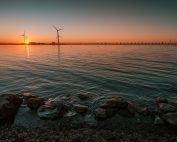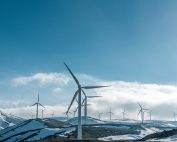The energy potential of the Polish part of the Baltic Sea is considered to be one of the largest in the region. For this reason, offshore wind energy will be a key tool enabling the construction of a modern, zero-emission and safe energy system – says Michał Kurtyka, Minister of Climate and Environment in an interview with BalticWind.EU.
BalticWind.EU: Is there a good climate for the development of offshore wind energy sector in Poland?
Michał Kurtyka: The energy potential of the Polish part of the Baltic Sea is considered to be one of the largest in the region. For this reason, offshore wind energy sector will be a key tool enabling the construction of a modern, zero-emission and safe energy system. According to the “Polish Energy Policy until 2040” (PEP2040), electricity generated in offshore wind farms will secure about 20 percent of Polish demand. The development of offshore wind energy also stimulates the Polish industry and, consequently, sustained economic growth, which is particularly important in the era of the pandemic slowdown.
A milestone in the development of offshore wind energy in Poland was the act on promoting electricity generation in offshore wind farms adopted in January this year, and in particular the support system established therein, approved already in May this year by the European Commission.
In the context of a good climate for the development of this innovative energy sector in Poland, it is worth noting that the works on a sectoral agreement for offshore wind energy initiated by the Ministry of Climate and Environment are supported by a wide range of investors and entities that will be part of the Polish supply chain. For the implementation of offshore wind energy in Poland, cooperation of all entities in the offshore wind energy sector is crucial, that is, electricity producers from offshore wind farms, producers of elements for the construction of offshore wind farms, service entities, transmission system operator, users of the national power system, maritime port authorities, terminal operators and maritime administration and environmental protection authorities. This good cooperation will create a new sector of the economy, which in turn will translate into the creation of tens of thousands of jobs, thus giving a chance for a fair and socially acceptable, sustainable energy transformation. Both domestic and foreign business inform us about the potential of the Polish supply chain and maritime infrastructure, and our task is to maximize this potential.
I believe that today there is a good climate for the adopted offshore wind energy development plan, and the goal set out in PEP2040, that is, 11 GW of energy from the sea in 2040, will be achieved. At the same time, I would like to emphasize that the activities of the Ministry of Climate and Environment are aimed at increasing these ambitions. In this aspect, I also assure you that we monitor market opinions, insights and experiences related to the application of regulations.
How much Poland will there be in offshore wind energy sector in the Baltic Sea? How is the work on the sectoral agreement going?
Work on the sectoral agreement regarding offshore wind energy was initiated by signing, on my initiative on July 1, 2020, a “Letter of Intent on cooperation in the development of offshore wind energy”. This is how the cooperation of entities interested in the construction and development of a new sector of the economy, which is offshore wind energy, began, including representatives of government and local government administration, entrepreneurs, organizations from the business environment, start-ups and implementation companies, industry organizations, universities and research and development institutes and independent experts. In line with the adopted formula, it was decided that the work on the Sectoral Agreement would be voluntary and open to all interested parties at every stage of the work, and the document itself would be developed on the model of the British “Sector Deal”, but based on the legal, social and economic conditions of the Polish market.
The main objective of the Agreement is to maximize the participation of Polish entrepreneurs in the offshore wind energy sector, to set local content goals in the following years of market development and to voluntarily adopt a catalog of good practices by the Partnership participants, strengthening mutual trust and allowing for optimization of the construction and development of the sector in Poland. The Sectoral Agreement also includes, inter alia, additional arrangements regarding the planned level of employment, training and education offer for future national staff or ensuring the preparation of facilities for the implementation of projects, including the use of the potential of the Polish shipbuilding industry.
The Ministry of Climate and Environment is committed to the greatest possible participation of Polish entrepreneurs in the development of offshore wind energy. We estimate that the total value of local content for offshore wind farm projects in the support system phase will be 25-35 percent and will continue to increase to reach the level and at least 45 percent until 2030 as part of the second, auction phase of the support system and over 50 percent after 2030.
Work on the sectoral agreement was carried out intensively at the Ministry of Climate and Environment from the moment of signing the Letter. In October 2020, 6 working groups were established, the work of which focused on key areas, that is:, 1) human resources development and education system, 2) research and development, 3) development of Polish industry and participation of Polish enterprises, 4) logistics of port facilities and impact on coastal regions, 5) social education, and 6) stakeholder cooperation. Working groups are a platform for the exchange of knowledge and experience between entities and communities involved in the development of the offshore wind energy sector.
What are the upcoming plans of the Ministry regarding offshore wind energy? What are you currently working on? Are there any elements that are missing for the full development of this industry in our country?
We are continuing legislative work on executive acts to the act on promoting electricity generation in offshore wind farms. We have already passed the regulation of March 30, 2021 on the maximum price for electricity generated in an offshore wind farm, which was set at PLN 319.6 / Mwh.
Recently, the Standing Committee of the Council of Ministers approved the draft regulation of the Council of Ministers on the concession fee, submitted by the Minister of Climate and Environment, which also includes an additional component of the concession fee for offshore wind farm producers.
The ministry is also working on the updated wording of the regulation on detailed requirements for elements of a set of devices used for power evacuation and for elements of power stations located at sea.
We submitted for public consultation the draft regulation of the Minister of Climate and Environment on the template of reports on the implementation of the supply chain plan for materials and services.
In order to take the next step in the development of offshore wind energy, it is also necessary to have an ordinance of the Minister of Infrastructure on the assessment of applications in the adjudication proceedings in order to open new locations in the Baltic Sea for offshore wind farms. As a minister co-participating in the issuing of this regulation, I hope that its adoption will enable the issuance of further location permits for the areas specified in the spatial development plan of Polish sea areas. This regulation will also allow investors to prepare their projects in a timely manner and participate in auctions for offshore wind farms, the first of which is scheduled for 2025.
We are in constant contact with the industry and other administrative bodies dealing with the development of offshore wind energy in order to optimize and maximize the full potential of the Polish Baltic Sea.
How big are the chances for wind farms to be developed with the help of Polish installation and service ports?
The implementation of modern and modernization of the existing maritime infrastructure for the construction of offshore wind farms is an essential aspect in the context of the production of clean, renewable electricity from the Polish Baltic Sea, resulting in a development impulse for the economy. We strive to ensure that the offshore wind farms planned in the Polish part of the Baltic Sea can be implemented with the greatest possible participation of Polish companies, supplying the necessary components and materials, and in the long run, providing maintenance and service services for them.
In order to build the Polish supply chain and improve the process of building offshore wind farms in the Polish part of the Baltic Sea, the Ministry of Climate and Environment secured funds for the construction of an installation terminal and at least two service terminals in the National Reconstruction Plan (KPO). According to the KPO, investments should be made in Poland: a deepwater installation terminal at the Gdynia Sea Port with an area of approximately 30 ha, which will enable the simultaneous operation of 2 installation units, and the ports in Łeba and Ustka with access infrastructure from the sea (including breakwaters) should be rebuilt in such a way as to enable the use of service terminals intended for servicing offshore wind farm service units.
As the needs for service ports on the Mid Coast are much greater, further investments are planned in this area within the available funds.
The deadline for the implementation of the investment for the installation terminal is expected by the end of the second quarter of 2025, while as for service terminals, this deadline is set at the end of the second quarter of 2026. A total of EUR 437 million will be allocated to investments.
Poland aspires to be the leader in the development of offshore wind energy sector in the Baltic Sea. We are approaching the first anniversary of the Baltic Declaration. What are the results of international cooperation so far and what are you planning for the next year?
The Baltic Declaration, which was signed in Szczecin on September 30, 2020, together with the European Commission and the ministers for energy: Denmark, Estonia, Finland, Latvia, Germany and Sweden, was the inauguration of regional cooperation for the development of the Baltic’s potential. Following the adoption of the Baltic Declaration, a new offshore wind energy working group was established under the aegis of the existing high-level group BEMIP (Baltic Energy Market Interconnection Plan), the aim of which is, inter alia, better coordination of investments in offshore wind farms in the Baltic Sea.
The BEMIP offshore wind energy working group covers four key areas: 1) coordinated offshore grid, 2) maritime spatial planning, 3) cooperation to enable adequate financing, 4) and acceleration of Baltic offshore projects, permits and market conditions.
So far, three meetings of the Group have been held. The result of its work is to achieve a common understanding of the needs of cooperation in the development of offshore wind energy between the region and the European Commission. Further work will enable the identification of best practices and standards for the areas of competence of the BEMIP group. The adoption of the Group’s work program, which will be revised in 2024, is scheduled for this fall.
The Baltic Declaration and the established BEMIP group is not the only form of international cooperation. The Ministry of Climate and Environment maintains bilateral contracts at the administration level, and a similar form of communication is also visible at the business level. In the coming years, we expect further international cooperation for the best development of the Baltic offshore wind energy sector and the local supply chain.
Thank you.















